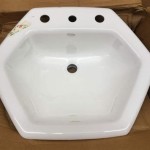Types Of Bathroom Sink Faucets
The bathroom sink faucet is a crucial element in any bathroom design, serving not only a functional purpose but also contributing significantly to the overall aesthetic. Selecting the appropriate faucet can enhance the visual appeal of the space while ensuring optimal performance and longevity. A diverse range of faucet types are available, each offering unique features and benefits to suit varying needs and preferences. Understanding the different types is essential for making an informed decision that complements the specific style and layout of the bathroom.
The choice of bathroom sink faucet extends beyond mere aesthetics. Factors such as water conservation, ease of use, installation requirements, and maintenance should be carefully considered. The material used in the faucet's construction, the valve technology employed, and the finish applied can all impact the faucet's durability and resistance to corrosion. Furthermore, compatibility with the existing sink and plumbing is paramount to ensure a seamless installation and optimal performance. This article aims to provide a comprehensive overview of the different types of bathroom sink faucets available, enabling homeowners and designers to choose the most suitable option for their needs.
Center-Set Faucets
Center-set faucets are a common and versatile choice for bathroom sinks, distinguished by their compact design that typically features a spout and handles mounted on a single base. This configuration makes them ideal for sinks with pre-drilled holes spaced four inches apart. The handles, which control the hot and cold water supply, are often integrated into the base of the spout, providing a streamlined and space-saving solution. Center-set faucets are available in various styles, ranging from traditional to contemporary, making them adaptable to a wide range of bathroom designs.
The installation of a center-set faucet is generally straightforward, especially when replacing an existing faucet of the same type. The single base simplifies the plumbing connections, reducing the risk of leaks or complications. However, it is important to ensure that the new faucet’s dimensions align with the existing sink’s hole spacing. Common materials used in center-set faucet construction include brass, stainless steel, and chrome, each offering varying degrees of durability and resistance to corrosion. Choosing a faucet with a high-quality finish is crucial for maintaining its appearance and preventing tarnishing over time.
Within the category of center-set faucets, there are variations in handle design and spout style. Handles can range from lever-style to cross-style, each offering a different ergonomic feel and aesthetic appeal. Spouts can be either rigid or swivel, depending on the desired functionality. A swivel spout provides greater flexibility in directing the water flow, while a rigid spout offers a more fixed and stable stream. When selecting a center-set faucet, it is essential to consider the water flow rate, which is typically measured in gallons per minute (GPM). Choosing a faucet with a lower GPM can contribute to water conservation without compromising performance.
Maintenance of center-set faucets is generally minimal, requiring only regular cleaning to remove mineral deposits and water spots. Over time, the valve cartridges may need to be replaced to prevent leaks or drips. Most manufacturers offer replacement parts for their faucets, making it relatively easy to repair and extend the lifespan of the unit. Regularly inspecting and cleaning the aerator, which is located at the tip of the spout, can also help to maintain optimal water flow and prevent clogging.
Widespread Faucets
Widespread faucets are characterized by their separate spout and handles, which are mounted independently on the sink deck. This configuration requires three pre-drilled holes in the sink or countertop, typically spaced eight inches or more apart. Widespread faucets offer a more spacious and elegant appearance compared to center-set faucets, making them a popular choice for larger bathrooms with ample counter space. The separate handles allow for greater customization in terms of style and placement, enabling homeowners to create a unique and personalized look.
The installation of a widespread faucet can be more complex than that of a center-set faucet, due to the separate plumbing connections required for each component. However, the flexibility in placement allows for greater control over the overall design. It’s crucial to ensure that the sink or countertop has the appropriate hole spacing and that the plumbing connections are properly aligned to prevent leaks. Widespread faucets are available in a wide range of styles and finishes, from traditional to modern, allowing homeowners to coordinate with other bathroom fixtures and accessories.
The handle styles for widespread faucets are diverse, including lever, cross, and knob designs. Each style offers a different tactile experience and aesthetic appeal. The spout design can also vary, with options such as gooseneck, arched, and waterfall spouts. A gooseneck spout provides a high arc for increased clearance, while an arched spout offers a more classic and timeless look. Waterfall spouts create a visually appealing cascade of water, adding a touch of luxury to the bathroom. When choosing a widespread faucet, consider the overall style of the bathroom and select a design that complements the existing décor.
The materials used in widespread faucet construction are typically the same as those used in center-set faucets, including brass, stainless steel, and chrome. However, the larger size and more intricate design of widespread faucets may require a higher level of craftsmanship and attention to detail. Investing in a high-quality faucet with a durable finish is essential for ensuring its longevity and maintaining its appearance over time. Regular cleaning and maintenance are also important for preventing mineral buildup and corrosion.
Single-Hole Faucets
Single-hole faucets, also known as single-lever faucets, are designed for sinks with only one pre-drilled hole. These faucets combine both the spout and the handle into a single unit, providing a minimalist and contemporary look. The single handle allows for easy control of both water temperature and flow rate, making them a convenient and user-friendly option. Single-hole faucets are particularly well-suited for small bathrooms or powder rooms where space is limited.
The installation of a single-hole faucet is relatively simple, requiring only a single plumbing connection. However, it is important to ensure that the faucet is properly sealed to prevent leaks. Some single-hole faucets come with an optional escutcheon plate, which covers any extra holes or blemishes on the sink or countertop. This can be particularly useful when replacing an existing faucet with a different configuration. The single lever design allows for easy operation even with wet or soapy hands, making them a practical choice for households with children or elderly individuals.
Single-hole faucets are available in a variety of styles and finishes, ranging from sleek and modern to more traditional and ornate. The spout design can vary, with options such as curved, angled, and waterfall spouts. The height of the spout is also an important consideration, as it should be tall enough to provide adequate clearance for washing hands or filling containers. Single-hole faucets often incorporate advanced features such as ceramic disc valves, which provide smooth and reliable operation while reducing the risk of leaks.
Maintenance of single-hole faucets is generally straightforward, requiring only regular cleaning to remove mineral deposits and water spots. Over time, the valve cartridge may need to be replaced to maintain optimal performance. Most manufacturers offer replacement parts for their faucets, making it relatively easy to repair and extend the lifespan of the unit. Regularly inspecting and cleaning the aerator can also help to prevent clogging and maintain a consistent water flow.
Wall-Mounted Faucets
Wall-mounted faucets are a unique and stylish option that adds a touch of sophistication to any bathroom. These faucets are mounted directly on the wall above the sink, eliminating the need for any holes in the sink or countertop. Wall-mounted faucets are particularly well-suited for vessel sinks or floating vanities, creating a clean and minimalist look. The installation of a wall-mounted faucet requires careful planning and preparation, as the plumbing connections must be concealed within the wall.
The installation process for wall-mounted faucets is more complex than that of other types of faucets, as it requires access to the wall cavity and the ability to run plumbing lines behind the wall. It is typically recommended to hire a professional plumber to ensure that the installation is done correctly and safely. Prior to installation, it's vital to accurately measure the distance between the wall and the sink to ensure proper spout reach. Incorrect spout placement can lead to discomfort or inconvenience during use. The height of the faucet above the sink is also an important consideration, as it should provide adequate clearance for washing hands and filling containers.
Wall-mounted faucets are available in a wide range of styles and finishes, from sleek and modern to more traditional and ornate. The handle styles can include lever, cross, or knob designs, and the spout design can vary to suit different aesthetic preferences. One added benefit of wall-mounted faucets is the ease of cleaning around the sink, as there are no faucet fixtures directly on the sink deck that can accumulate dirt or water spots. This can lead to a cleaner and more hygienic bathroom environment.
Wall-mounted faucets provide versatility in design, allowing for more counter space and a cleaner, more uncluttered look. However, maintenance may require accessing the plumbing behind the wall, which could involve more extensive repairs than with sink-mounted faucets. Due to their unique installation requirements, the cost of wall-mounted faucets, including installation, might be higher than other types of bathroom faucets. Regular inspections and maintenance are important to ensure the faucet's longevity and optimal performance.

What Are The Diffe Types Of Bathroom Faucets

Bathroom Faucet Guide Unique Vanities

What Are The Diffe Types Of Bathroom Faucets

Bathroom Guide Lavatory Faucet Considerations Kohler Ph Kitchen And Blog Posts
:strip_icc()/102354379-7d2e223539fe46f0809e380c1a34fa52.jpg?strip=all)
Types Of Bathroom Faucets
Bathroom Faucets Kingston Brass

Bathroom Sink Faucet Finishes You Need To Know Facets Of Lafayette
Types Of Bathroom Sink Faucets Styles Finishes Color Coordination

4 Diffe Kinds Of Sink Faucet Mike Diamond

10 Types Of Bathroom Faucets Guide Blossom Kitchen Bath Supply Corporation
Related Posts







